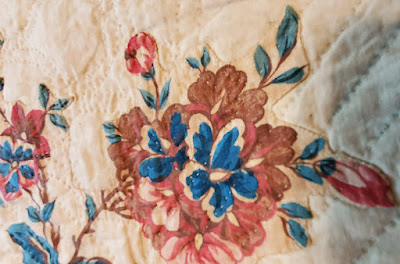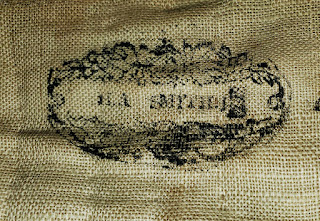South Carolina quilt
The Six Know It Alls have a Facebook group
6KnowItAlls:ShowUsYourQuilts
The floral's ivory background matches the shade of the body of the quilt top
so well that the appliquer could cut rather loosely around the
floral images.
We also gave her some ideas about the quilt itself expanding on her knowledge that it was Broderie Perse and from South Carolina. I thought I'd summarize the information and expand further. Dawn noticed right away the quilt's quality and showed us large photos, which I was able to blow up to show details.
We have here a cut-out chintz applique quilt (a style we tend to call Broderie Perse or Persian Embroidery). Florals are arranged medallion style with a central image framed by eight repeated large florals in the corners and at the north/south axes. The large florals seem to be cut from the same chintz.
I didn't recognize the print so I went to Terry Terrell's and Deborah Kraak's remarkable website Flowers On Chintz and looked at their index to red or pink florals. The main flower seems to be a popular subject, a Double Anemone (Anemone coronaria). I didn't see the exact print.
Nor did I find the print from which this central ring of small scrolls was cut.
My first guess---a furniture panel---but Merikay Waldvogel has her own
extensive index to panels for chair covers, etc in chintz and she didn't recognize it either.
Charleston Museum Collection
Charleston Museum Collection
The Museum has quite a few similar quilts, these two with central
florals cut from furniture panels rather than from repeat chintzes of scattered florals.
They are displaying their chintz quilts till December this year:
The border is a single piece of furniture-scale fabric, a stripe
alternating a scroll background with a moiré ground.
The quilting is rather utilitarian, an all-over pattern of parallel diagonal lines framing
squares full of double shells that goes across the applique motifs.
The backing looks to be a coarse cotton or linen
and on it is a stamped name "H.? A. Smith," who may have been
the quilt's owner. The stamped name is typical of the mid-19th century.
(Great to have a name---too bad the name is Smith so any genealogical work
might find far too many Smiths in South Carolina.)
As far as a date: Merikay and I spent quite a bit of time examining chintz panel quilts and did a blog for a year or so on the topic in 2018 & 2019. One of our conclusions based on date-inscribed examples was that the style lasted from about 1825 to 1855.
We also came to the conclusion that these Southern chintz appliques were purchased by plantation families as finished quilts or finished unquilted bedspreads in Southern commercial centers.
See a post on our conclusions:
http://chintzpanelquilt.blogspot.com/2019/10/conclusions-3-who-made-these-panel.html
http://chintzpanelquilt.blogspot.com/2019/10/conclusions-3-who-made-these-panel.html
Dawn thought there were two other quilts in the family inheritance. What a treasure trove.
And we will remind you: Show Us Your Quilts. The Know-It-Alls love to discuss quilts---hence our name.
















Gracias por toda la información que aportas, Bárbara. Un saludo.
ReplyDeleteGracias
Delete